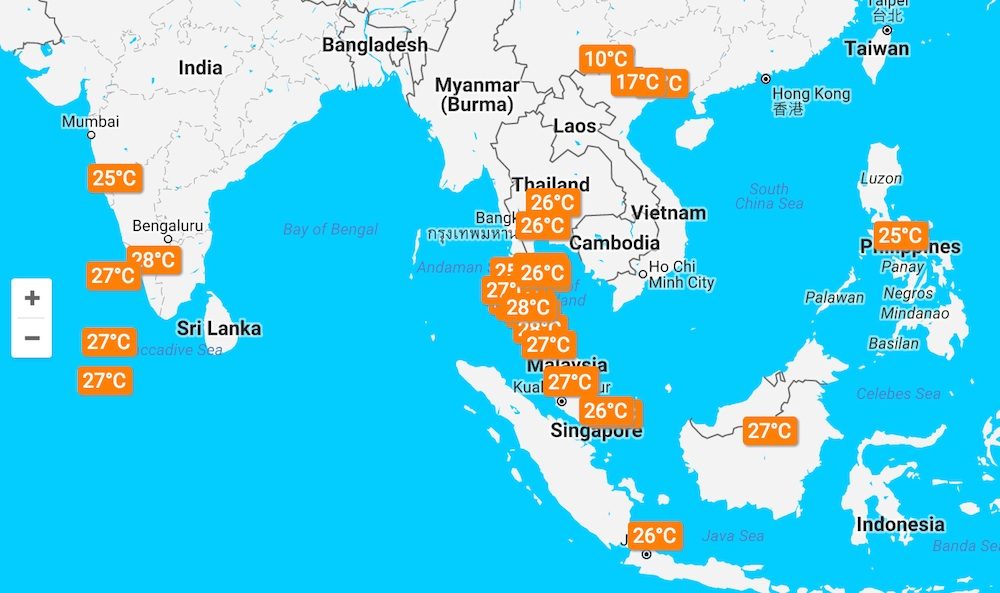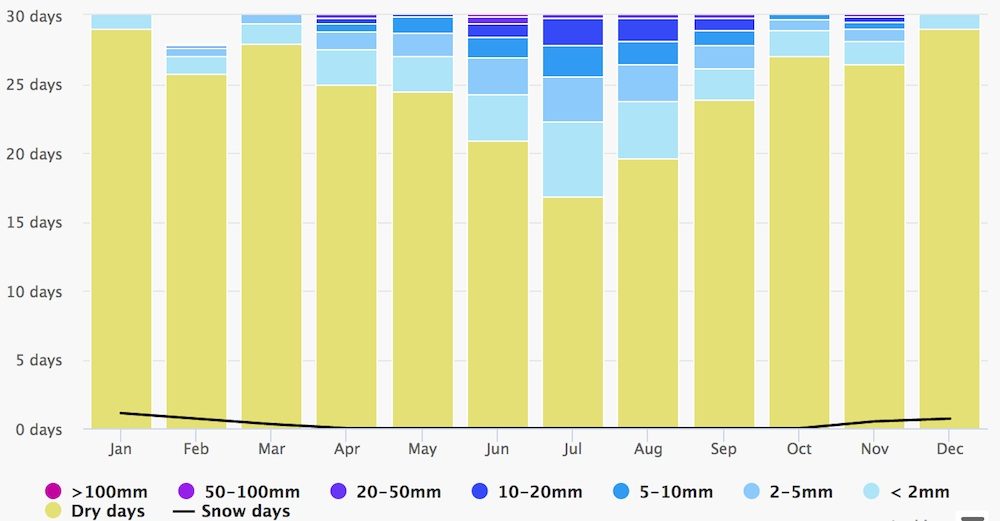Table of Contents
One of the first things that I look at before committing to a new bike tour is the weather. The weather dictates so many factors like what clothes I’ll need to pack, how far I can ride in a day and how much water capacity I’ll need to prepare. By researching weather a little, you’ll enjoy the conditions more and will carry only what you need.
Most of my planning is conducted weeks or months in advance. That makes ‘weather averages’ my friend; data which is collected over a series of decades to best predict local conditions at a certain time. If I were going to pick one website to analyse weather information, I’m going to recommend WeatherSpark.
While I’m travelling I try to check out the 7-Day forecasts. These can be a great way to plan out a rest day in adverse conditions. I tend to like MeteoBlue for up-to-date weather information, or WindyTV for beautiful map-style forecasts.
This article will take you through many of the other services I use to ensure I am best prepared for any bike trip!
Temperature Min, Max and Averages
I love clear, moderate days on the bike, so temperatures are the first thing that I will research when planning a bike trip. Daily temperatures largely determine what gear I’ll bring along too. Can I get away with ultralight gear, or do I need to prepare for four seasons in one day?
I start by using the HolidayWeather map. You’ll need to hit ‘weather averages’, then you can select the month you want to travel, and scroll around until you find a location with your preferred climate. This map is really handy for longer tours where you’re planning a month-to-month route.
The next step is to look at the average high and low temperatures. You can do that through any of the large weather websites like MeteoBlue, WeatherSpark, Wunderground or HolidayWeather. This information helps understand what clothes, sleeping bag and tent will be most appropriate for your trip.
Wind Direction and Speed
Understanding wind direction is one of the best ways to increase your average speed on the bike! It’s especially handy to know for a point-to-point trip across a country or continent because… tailwinds. 😉
I use WeatherSpark to determine wind speed and direction for most countries, just make sure you select ‘averages’ when searching. You can find ‘wind’ at the bottom of your searched page. The data shows which months are the windiest, and the directions to expect the wind from. WindFinder is another option. Simply click on the ‘wind statistics’ section to get monthly dominant wind directions and distribution graphs.
Wind roses are my favourite graphical representations of how wind speed and direction are distributed. Unfortunately, there’s no free website or app that shows month-by-month wind rose information for all cities/countries. That said, MeteoBlue has wind roses for all countries, albeit only with yearly averages. For those travelling Australia, the BOM website has excellent wind rose data.
To check the current wind direction and predictions at particular locations, check out WindyTV. This website is one of the nicest 7-day weather map services around!
Rainfall
I like to try and stay dry, so I always check out the rainfall charts! But sometimes rain can’t be avoided…
Monthly rainfall charts give you an idea how likely it is to rain. Head to MeteoBlue or to see some nice monthly precipitation charts. That said, high rainfall doesn’t necessarily mean all day rain. It doesn’t even mean it will rain on every day – it’s just an indicator for the quantity of rain. With a bit of planning online (radars/precipitation probability) you can actually do a good job of avoiding the rain.
When I have access to the internet I use rain radars in combination with precipitation probabilities to plan when to shelter, have lunch or plan a rest day. AccuWeather and WindyTV offer global rain satellites, but sometimes local weather websites have better quality radars.
Sunrise and Sunset
The sunlight duration will likely determine what you fit into your day. Whether that’s extra kilometres on the bike or more time for leisure activities, daylight hours are well worth noting.
In general, you’ll find it’s light enough to see about 30 minutes before and after the sun rises and sets.
There’s No Such Thing As Bad Weather

Despite how much I try to plan around ‘good’ weather, I’d like to stress that you can bike tour in any weather condition. Don’t wait for the perfect conditions. If the time suits you and the place is somewhere you’ve always wanted to go – just do it, but remember to bring the appropriate gear. After all, there’s no such thing as bad weather, just inappropriate clothing.







Here in the States I have used usclimatedata.com quite a bit. It gives a good bit of data for temperatures and precip. down to the city level, as well as historical data which has been helpful given the changing weather patterns over the last couple of years. But, alas, no wind direction data. For that I generally can’t get anything reliable farther than 10 days out. Granted predicting long-term wind patterns on a continent so large is difficult especially given the drastic swings in weather which can occur especially in the Spring and Autumn months.
Thanks for the suggestion! Wind data is generally only accurate a few days out, but I still like checking the long-term trends to see which way to do a point-to-point tour.
Yeah, wind is the bugger. Low temps I can deal with, but high winds are a mood killer. By the way, thanks for all you have shared for the rest of us over the last few years. Your experiences and sharing of them have been a big help to me in many different ways.
Thanks for the article, but you left out something I’ve always found critical if I’m planning to camp out. As the author of another bike touring web site discovered in Alaska, you need to always check the record temps as well as the averages. In Alaska and I’m betting a lot of places, the actual weather can vary greatly from the averages. For example, in October the average high and low here is 30F and 15F respectively. But the record low is 0F (-19C) with a high of +50F/+10C. So, if I’m planning to camp out in October, I’ll be prepared for 0F/-20C and hope for +50F/10C. If you’ve got a warm room waiting at the end of the day it’s not so critical. Thanks again. Phil
Great point, Phil!
yr dot no. especially their rain radar predictions. nuff said